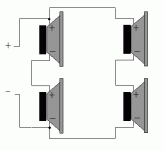alwaysredee
Member
I love it! I used to steal that stuff back in the day! Rock on and keep the spandex! It insulates well now that we're older!
Rock on and keep the spandex! It insulates well now that we're older!

Welcome to the Checkmate Community Forums forums.
You are currently viewing our boards as a guest which gives you limited
access to view most discussions, articles and access to our other FREE features.
By joining our free community you will be able to:
Registration is fast, simple and absolutely free so please, join our community today!
If you have any problems with the registration process or your account login, please contact support by clicking here or by using the"contact us" link at the bottom of the page.


I did notice some rather vague applications of Ohm's Law. Remember, if you raise voltage, you lower current, at least on this planet.


You could run the four highs
(4 ohm) speakers in parallel and get a dual voice coil sub (4 ohm). There you go by wiring the highs in parallel it will drop the 4 ohm speakers to 2 ohm thus doubling the wattage. By getting a DVC (dual voice coil) sub you could hook it up to the two left over channels. The sub would run at 4ohms.
So four speakers in parrellel on channels 3 & 4. The one DVC sub on channels 1 & 2. So six speakers. I think most people here would be happy with 4 speakers and a sub.

All true, and I wanna apologize for my part. Maybe I didnt exercise the best tact in the my replies. I tried to delete my recent messages, but could only delete the last one. Moderators, feel free to eliminate the argumentative stuff. It's apples to oranges, and everyone will have different opinions. Maybe if ThaPhillips is still checking the thread, we could amend a few things in his original posts and make this an audio sticky. Might avoid alot of questions.
Sorry for arguing as well. Unfortunately it doesn't let me edit my posts now, so I can't amend anything in prior posts.
When you say optimum do you mean greater output (db) or greater clarity and precision?I agree, great thread for reference material, thanks guys. One question that didn't come up - What direction should a sub be mounted to give the optimum output, cone up???
